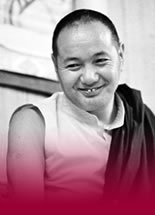Robina’s Blog
16 March, 2023
We have sensory consciousness and mental consciousness, and they cognize phenomena in very different ways. Eye consciousness, for example, is that part of our mind – effectively “consciousness” and “mind” are synonyms – that, through the medium of the eyeball and the bits and pieces working nicely, cognizes precisely two things: shape and color. It’s in fact profoundly limited in its capacity for cognition.
We’ll say, oh, what a lovely-looking cup. Well, if it’s not our eye consciousness – which, remember, being mind, is necessarily not physical – that’s cognizing a lovely-looking cup, which part of our mind is doing that job?
That’s our mental consciousness – as Lama Zopa Rinpoche puts it, “that’s where the workshop is.” That’s where all our thoughts and feelings and emotions, our subconscious, intuition, our memories are – you name it.
Interestingly, everything we’ve ever seen, heard, thought about, tasted, touched, smelled – and not just in this life – is stored there, nothing goes astray.
So, what’s happening then? The millisecond my eye consciousness lands on that cup, sees that shape and color, quicker than Google my mental consciousness is accessed and up comes the thought, what a nice-looking cup.
It’s a concept, an opinion, a viewpoint. And this is how we experience the world every minute! Wow!
From Buddha’s perspective, there are concepts that are valid – those that are in sync with reality; and there are concepts that are not valid – those that are not in sync with reality.
In the simplest sense of conventional reality, we get that. There’s a blue cup there but because my eyeball or whatever has a problem, pink appears to my eye consciousness. That’s not a valid concept. Why not? Because in the world we all agree that color is called blue.
But what about when it comes to a nice-looking cup? How do we find reality here? Well, our mothers would tell us that beauty is in the eye of the beholder, and that’s just fine. It’s okay to have an opinion in cases like this. But our problem is we don’t think it’s an opinion; we think it’s a fact, we think it’s reality; we think that “nice-looking cup” is a quality coming from the cup, in the cup itself – and if you don’t see it too, if you don’t agree with me, then you’re wrong.
We live our lives like this!
What’s really surprising to us is Buddha’s take on what we call emotions: love, anger, depression, jealousy, and the rest: these are, at the most fundamental level, concepts, viewpoints, opinions, too.
And, even more surprisingly, the neurotic unhappy ones such as attachment and anger are misconceptions and necessarily not valid; and the positive ones, the virtues such as love and compassion, are also concepts, and are valid. This approach to the mind is at the heart of Buddhist psychology.
This is not a moralistic issue. We’re talking about learning to identify in our minds the causes of our suffering, and for the Buddha attachment and anger and the rest of the neuroses are the source of our pain. Why? Because they’re misconceptions. They’re viewpoints that don’t have a valid base.
Specifically, they are misconceptions insofar as they distort the object, causing it to “appear back to us,” as Lama Zopa says, in the aspect of whatever’s in our mind. When attachment predominates, the cake will look so divine. When aversion is there, the boyfriend who cheated on me will appear so ugly. They are concepts that are literally not in sync with what is right there.
We give so much power to the body – we make the body the boss, as Lama Yeshe says. It’s clear that body and mind are intimately connected, but we need to be accurate in our assessment of what’s going on. It’s hard to hear that anger is a concept – a misconception – because all we notice are the feelings in our body, the immense agitation. And the stronger the habit of anger, the more intense the physical agitation. But anger is not a function of the body; it’s within our mind, it’s mental. And our trouble is we don’t pay attention to what’s going on in our mind until we feel it in our body.
And why are love and compassion valid concepts? How are they in touch with reality? Because they’re rooted in a sense of dependent arising, interdependence, and that’s literally the way things exist conventionally.
When love predominates, there’s a sense of connectedness with the other person, isn’t there? The neurotic sense of me, I, has subsided to some degree and “we” predominates. That’s reality! We are in fact interconnected. Of course, until we’ve realized emptiness, there’s still a feeling of a self-existent me having self-existent love for a self-existent you – but it’s a good step in the right direction.
So, as Lama Yeshe says, we need to learn to be our own therapist: to gradually distinguish between what is to be abandoned – the delusions, the misconceptions – and what is to be practiced – the virtues, the valid concepts.
One step at a time.

